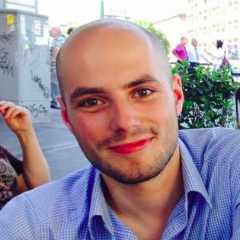Visitors to Milan's Expo site will be bowled over by the scale of it all. From the foot of the 1.5km "Decumanus" boulevard, there is no discernible end in sight. A stream of people flows between the garishly clad pavilions housing 145 participating nations, where inside you'll find eccentric exercises in design and exhibitions on sustainability - Feeding the planet, energy for life is the theme - in addition to countless sources of real nourishment: "pommes frites" at the Belgian pavilion or pitchers of Munich beer in Germany's eco-chic haven. Along the perpendicular "Cardo", there's the 11,000 seater open air theatre for the Cirque du Soleil, dwarfed only by the vast pond of the Lake Arena with its miniature forest and the 37m tall Tree of Life.
Milan has gone large for this instalment of the same world fair that brought the Crystal Palace to Hyde Park in 1851 and the Eiffel Tower to Paris one hundred years after the storming of the Bastille. The months of preparation leading up to the 1st May launch in Milan may have been a list of controversies - delayed works, an unfinished metro line, mafia collusion, costs spiralling to €13bn, Pope Francis wading in to decry the wastage - but there is nevertheless a huge sense of anticipation in the city, with 20 million people expected to visit during the six month period and Prime Minister Matteo Renzi branding the event a new start for a country in deep economic crisis. An explosion of cultural events in the city of Milan accompanies the Expo itself, most of which are organised under the all-pervading cultural banner of "Expo in Città".
Currently, the sound of music bristles all over the city like a rash. Jazz lovers flock to the Città Studi quarter for "Il Ritmo delle Città" from May to July (a collaboration with the Torino Jazz Festival), whilst city centre strolls turn into evening jives in the exquisite surroundings of the Piccolo Teatro Grassi's cloisters. Similarly atmospheric, a 16th century court provides the setting for the Sforza Castle's "Estate Sforzesca" music festival, though there has been none better for outlandish fun than the "Festa della Musica" - Milan's version of Paris's Fête de la Musique - which saw music spill out into the streets in a four-day carousal during last weekend's summer solstice. Music is contentiously at the heart of the Expo festivities: the whole event was officially opened with a concert in the Duomo's heaving piazza. Diana Damrau joined Andrea Bocelli and the orchestra of La Scala for favourite operatic arias, and Lang Lang played on a Steinway made of marble.
The city's full-time music institutions have pitched in with their own contributions, not least with an extended season from LaVerdi orchestra characterised by adventurous programming. One striking feature is their commission of The Expo Variations from Italian composer Nicola Campogrande, whose twenty-four instalments are dedicated to various nations hosted at the Expo in a rich spread of patriotic flavours. Peckish concert goers can now enjoy a post-concert meal at "M.A.C.", the orchestra's new arts centre and restaurant situated a stone's throw from the Auditorium di Milano, whilst La Verdi's continuing partnership with "ATMosfera" means that, alternatively, you can board a converted 1928 tram-restaurant for a tour of the city and a three course meal. (Original versions of the trams are still a trademark sight in the city thanks to their maintenance by transport company ATM.)
There are rich pickings for opera lovers too. La Scala's extended season consists largely of recent hit productions and old favourites such as Zeffirelli's La bohème. Seasoned punters have also been drawn by the inclusion of fresh material, including a delicious production of Turandot with Riccardo Chailly (first seen at Dutch national Opera but new to Milan), promptly followed by a commission from Battistelli - CO₂ - which neatly meditates on the sort of environmental themes highlighted at the Expo proper. Still to come, a new, futuristic production of Rossini rarity Otello features Juan Diego Flórez, previously heard at La Scala only last week in his recital of accompanied arias, whilst a handful of other juicy names litter the opera house's recitals roster, with Jonas Kaufmann, Jose Carreras and Ramón Vargas to name just the tenors.
La Scala's International Orchestras Festival is perhaps the highest profile music event of the entire period. It draws the best of orchestral royalty to the city, from the Boston, Berlin and Vienna Philharmonic Orchestras to Iván Fischer's Budapest Festival Orchestra and Nikolaus Harnoncourt's Concentus Musicus Wien. Mahler's symphonies form the backbone of the series, whilst Beethoven also features prominently in offerings from the Cleveland Orchestra and Antonio Pappano's Orchestra dell'Accademia Nazionale di Santa Cecilia. Rather less monolithic, breezier programmes are presented by South American youth orchestras during a two week period in the middle of the festival, forming a tantalising "El Sistema" festival within a festival.
Apart from the breadth of events on offer, it is the way that various of them promise to broaden our perspective of the city that makes for such a sense of occasion. Frequently described as a hidden city, many of Milan's gems reside in courtyards set safety behind palazzi walls. "Piano City Milano" saw forbidding gateways thrust open over 3 days for 350 concerts of piano music. The July "Milano Arte Musica" early music festival draws audiences for the Tallis Scholars and Westminster Cathedral Choir, amongst others, into the city's churches and basilicas otherwise so easily missed. "MITO SettembreMusica", the world-renowned joint effort between Turn and Milan, presents "all shades of music" (as the gloriously technicolour poster proclaims) in concerts in lesser-known theatres as well as mainstream locations.
The New York Times recently voted Milan the number must go destination for 2015 - with so much happening in the city, who could argue? For music pilgrims, the destination at least is a no-brainer. Milan is the only place to be this summer.




